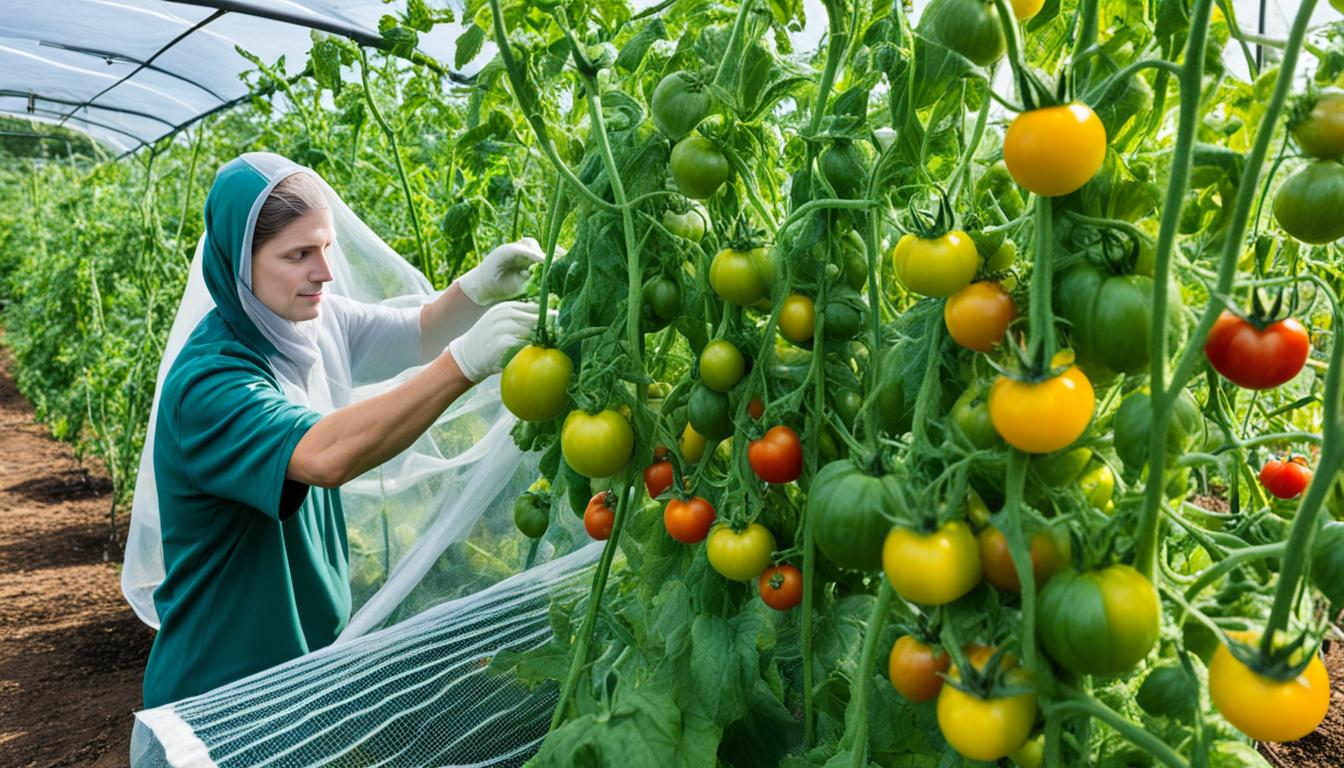“The greatest glory in living lies not in never falling, but in rising every time we fall.” – Nelson Mandela. This quote shows the strength needed to beat pest problems in tomato gardens. Tomatoes are a favorite in many gardens but bring pests that can harm your plants and cut your harvest. Pests like spider mites, tomato hornworms, aphids, and leafminers are common. To protect your tomatoes, you need the right tools and methods.
This article will cover 10 key pest control tools to keep your tomato garden safe and free from pests.
Key Takeaways
- Effective pest control tools are crucial for protecting tomato plants from damaging pests
- A range of tools, from insecticidal soaps to beneficial insects, can be used to control common tomato pests
- Organic and natural pest control methods are preferred for a healthier, more sustainable tomato garden
- Early detection and proactive management are key to successfully controlling pests in tomato gardens
- Investing in the right gardening tools can make pest control more efficient and effective
Introduction
Keeping your tomato garden healthy and free from pests is key to a great harvest. Pests like spider mites, tomato hornworms, aphids, and leafminers can harm your plants. We’ll talk about why pest control for tomatoes is important. We’ll also look at the essential pest control tools gardeners need to protect their tomatoes.
Importance of Pest Control in Tomato Gardens
Managing pests is vital for healthy tomato plants. Pests can damage leaves, slow growth, and lower fruit production. Without pest control, your plants could suffer from leaf damage or even fail to produce any fruit. It’s important to use pest control to help your tomatoes grow well and give you a good harvest.
Overview of Essential Pest Control Tools
We’ll look at 10 effective tools for keeping pests away from tomatoes. These include organic options like insecticidal soap and neem oil. There are also physical barriers like row covers and sticky traps. Using these methods together can help gardeners fight pests and keep their tomatoes healthy all season.
“Effective pest control is crucial for growing healthy, bountiful tomato plants. By using a combination of organic and physical pest control methods, gardeners can ensure their tomato plants reach their full potential.”
1. Insecticidal Soap
Insecticidal soap is great for fighting pests in tomato gardens. It comes from potassium salts of fatty acids. This makes insects dehydrate and die. Insecticidal soap works well against aphids, spider mites, and leafminers.
Key Features
This soap is safe and organic. Use it as a 1 to 2% solution, which is 2½ to 5 tablespoons per gallon of water. You might need to spray it every 4 to 7 days to get rid of pests. It doesn’t last long and needs to touch the pests to work.
Benefits and Application Methods
Make sure to spray the underside of leaves and stems well. Hard water can make it less effective. Use soft water or add a water-softener if needed. Some plants like portulaca might get damaged, so test it first.
This soap is very safe for animals and birds. Making your own can save money on pest control. Brands like Des-X are good choices for tomatoes.
| Insecticidal Soap Statistics | Details |
|---|---|
| Solution Concentration | 1 to 2% solution (2½ to 5 tablespoons per gallon) |
| Reapplication Frequency | Every 4 to 7 days until pests are eliminated |
| Sensitive Plants | Portulaca, hawthorn, sweet pea, cherries, plum, horse chestnut |
| Effective Against | Soft-bodied pests like aphids, whiteflies, spider mites, mealybugs |
| Active Ingredient | Potassium salts of fatty acids (typically 47%) |
| Toxicity | Virtually non-toxic to animals and birds |
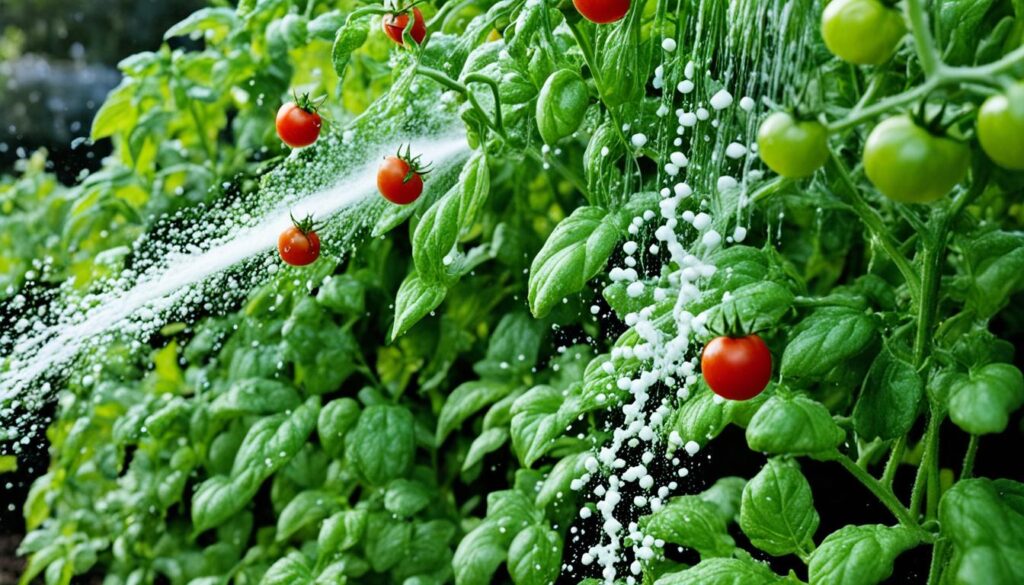
In summary, insecticidal soap is a top choice for fighting pests in tomato gardens. It’s eco-friendly and works well against many pests. By knowing how to use it, gardeners can keep their plants safe without harsh chemicals.
2. Neem Oil
Neem oil is a great way to keep pests away from tomato gardens. It comes from the neem tree seeds. This oil stops pests from eating, breeding, and shedding skin. It’s great against aphids, spider mites, and leafminers.
How Neem Oil Works
Neem oil has over 100 active parts, like Azadirachtin and Nimbin. These stop insects from living and harm them at different life stages. It also fights some fungal diseases by stopping spores from growing and getting into leaves.
Usage Tips and Benefits
- Apply neem oil in the early morning or late evening to avoid harming the plants.
- Put it on every 7-14 days and after watering or rain to keep it working.
- It’s safe for people, pets, and good insects, making it a good choice for gardens.
- It also protects tomatoes from some fungal diseases.
Neem oil is a great tool for fighting pests and diseases in tomato gardens. By knowing how it works and how to use it, gardeners can keep their tomatoes healthy all season.
| Neem Oil for Tomatoes | Key Benefits |
|---|---|
| Natural Insecticide, Fungicide, and Miticide |
|
| Disrupts Pest Life Cycle |
|
| Requires Proper Application |
|
3. Diatomaceous Earth
Diatomaceous earth is a natural, safe way to fight pests in tomato gardens. It comes from the fossilized remains of tiny sea creatures. This powder is great against pests that bother tomatoes.
Natural Insecticide Properties
This powder hurts pests like aphids and spider mites by damaging their outer shells. The sharp edges of the powder cut through their protection. This makes them dry out and die. It’s a safe choice for gardeners who want to avoid chemicals.
Application Techniques
- Lightly dust diatomaceous earth around tomato plants, focusing on the soil and the undersides of the leaves where pests tend to congregate.
- Reapply the powder after heavy rains or extensive watering to maintain its effectiveness, as it can be washed away.
- Wear a dust mask and gloves when handling diatomaceous earth to avoid inhaling the fine powder or irritating your skin.
- Be cautious when using diatomaceous earth near bee-attracting flowers, as it can potentially harm beneficial insects. Apply it carefully and avoid spraying it directly on flowers.
Using diatomaceous earth in your garden helps control pests without harsh chemicals. It’s a safe, green way to keep your tomatoes healthy.
4. Beneficial Insects
Managing pests in your tomato garden can be easy with beneficial insects. These insects eat pests like aphids, spider mites, and tomato hornworms. This keeps your plants healthy and strong.
Types of Beneficial Insects
Some great insects for tomato gardens are:
- Ladybugs – These eat hundreds of aphids every day. They are a big help in fighting pests.
- Lacewings – Adults and larvae eat aphids, spider mites, and other pests.
- Parasitic Wasps – These wasps lay eggs inside aphids, getting rid of them in your garden.
How to Attract and Release Beneficial Insects
To draw beneficial insects to your garden, plant flowers and herbs like dill, fennel, and yarrow. These plants give food and shelter to the beneficial insects. You can also buy and release these insects right on your tomatoes for more pest control.
Using beneficial insects in your garden helps you control pests without harsh chemicals. This method protects your plants and keeps your garden healthy and balanced.
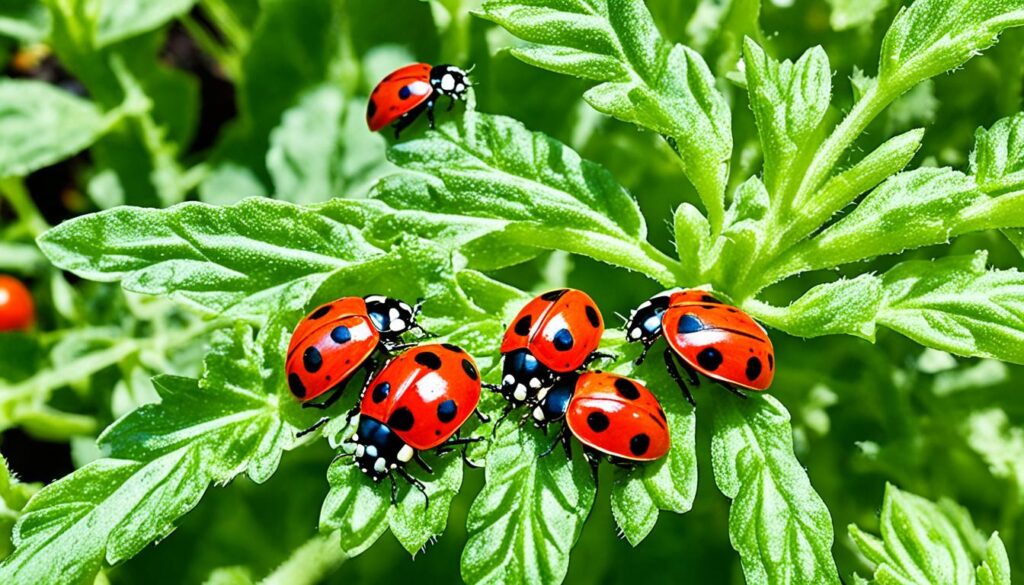
5. Row Covers
Row covers are great for keeping pests away from tomato gardens. They act as a shield that lets sunlight, air, and water in but keeps pests out. Let’s look at the different types of row covers and how they help stop tomato pests.
Types of Row Covers
There are a few types of row covers for your tomato garden:
- Spun-bonded fabrics are light and let air and water through but keep pests out.
- Insect netting is strong and stops aphids, leafminers, and other bugs from reaching your plants.
- Floating row covers are easy to use, reusable, and keep out many pests like butterflies and moths.
Using Row Covers for Pest Prevention
Here’s how to use row covers to keep pests away from your tomatoes:
- Put the row cover over your tomato plants, making sure it fits tight around the base.
- Use hoops or frames to hold the row cover up over your plants.
- Keep the row cover in place with soil, rocks, or weights.
- Take off the row cover when your plants are flowering so bees can pollinate them.
- Take good care of your row covers to make them last longer and work well every season.
Adding row covers to your garden helps protect your tomatoes from pests without using harmful chemicals. Floating row covers, insect netting, and other options can really help keep your tomatoes safe and healthy.
“Row covers are a must-have for any organic tomato garden. They provide an effective barrier against pests while still allowing your plants to thrive.”
6. Sticky Traps
Sticky traps are a simple way to catch common tomato pests. They have a sticky surface that traps insects like aphids and whiteflies. By placing them in your tomato garden, you can see what pests you have and control them.
Different Types of Sticky Traps
There are many types of sticky traps for controlling pests:
- Yellow sticky cards: These traps catch whiteflies, aphids, moths, leafhoppers, and leafminers.
- Blue sticky traps: These are great for monitoring thrips.
- Black sticky trap rolls: They help control the Tuta absoluta pest, which can harm tomato plants.
- Red sticky traps: These traps catch cicadas.
Sticky traps have dry or wet adhesive. Dry traps are for watching pests, while wet traps catch more insects.
Placement and Effectiveness
Put sticky traps around your tomato garden or where pests are seen. Check and replace them often. They help you see what pests you have and when they’re a problem. This lets you take action.
Studies show sticky traps work well against tomato pests. For example, yellow sticky traps can reduce insects by up to 80% overnight. But how well they work depends on the pest and the environment.
Using sticky traps in your pest control plan helps you manage pests. This protects your plants and ensures a good harvest.
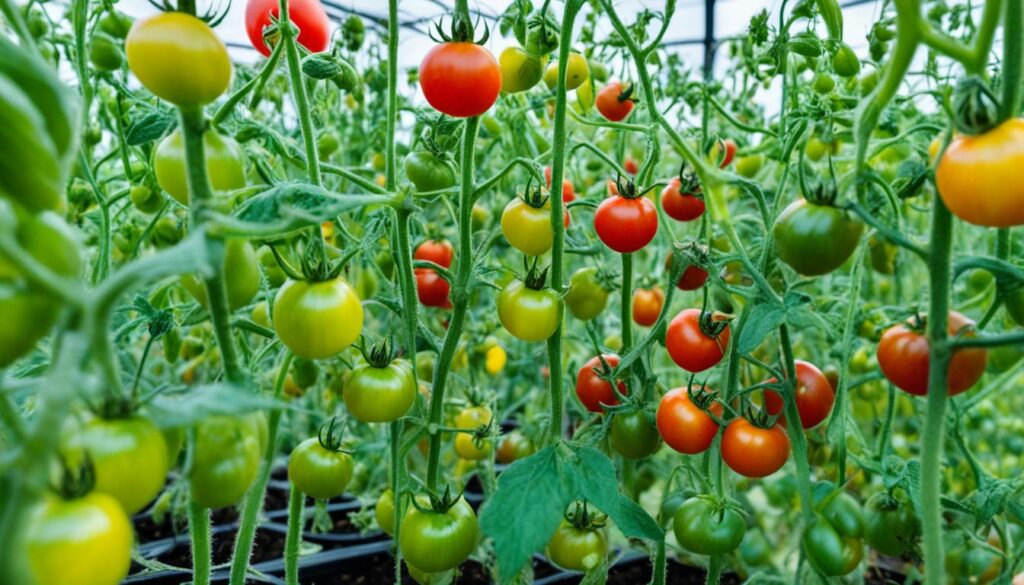
7. Handheld Vacuum
A handheld vacuum is a great tool for fighting off tomato pests. It’s small and light, making it easy to use. You can quickly pick up big pests like tomato hornworms right from your plants.
Using a handheld vacuum for tomato pest control means you don’t have to use harsh chemicals. Or worry about hurting your tomatoes.
Removing Pests with a Handheld Vacuum
Act fast and be precise when using a handheld vacuum for pests. Hornworms and other pests are most active early in the morning and late in the evening. This is when you should vacuum them up.
Guide the vacuum’s nozzle over the pests carefully. Make sure not to hurt the plants. Empty the vacuum often to keep the pests from getting out.
Best Practices for Use
Here are some tips for using a handheld vacuum to remove pests:
- Avoid using the vacuum on delicate plants or flowers, as the suction can cause damage.
- Be gentle and patient when maneuvering the vacuum around the plants to avoid harming them.
- Dispose of the collected pests securely, such as by placing them in a sealed bag or container.
- Clean the vacuum’s filters and canister after each use to maintain its efficiency.
Follow these tips to effectively use a handheld vacuum for tomato pest control. Keep your garden healthy and pest-free. For more info on the best handheld vacuums, check out this review.
“The Ryobi 18V One+ Performance Hand Vacuum Kit runs for 18 minutes, outlasting other vacuums that commonly run out of juice within a few minutes in boost mode.”
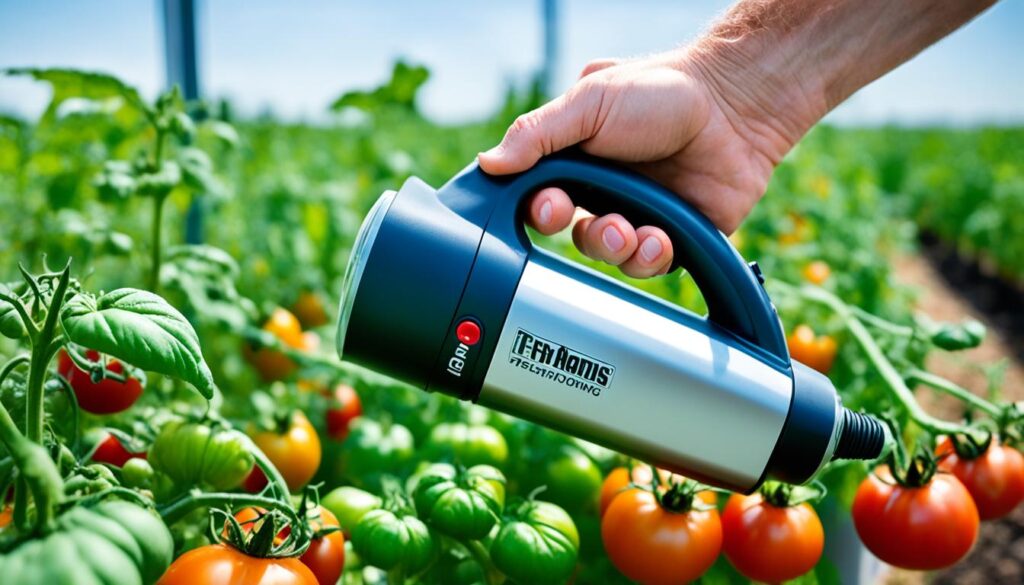
8. Companion Planting
Companion planting means growing different plants together for their benefits. This method can help keep pests away from tomato gardens naturally. Plants like marigolds, basil, and tansy can keep pests like aphids and hornworms away.
The strong smells from these plants make tomatoes less appealing to pests.
Plants that Repel Pests
Here are some plants that help keep pests away from tomatoes:
- Marigolds – Deter whiteflies
- Basil – Repel thrips and tomato hornworms
- Oregano – Attract beneficial insects and pollinators
- Nasturtiums – Attract aphids and other pests away from tomatoes
- Thyme – Lower the rate of egg-laying by adult armyworms
- Radishes – Preferred by flea beetles over tomatoes
- Garlic – Effective against red spider mites
- Dill – Provide nectar for beneficial insects like braconid wasps and ladybugs
- Carrots – Help break up the soil with their long roots
Benefits of Companion Planting
Companion planting also brings in beneficial insects that eat tomato pests. This creates a healthy garden ecosystem. By placing these plants near tomatoes, you can stop pests from reaching them.
Companion planting can reduce pest damage, improve soil health, fight weeds, and increase crop size.
Studies show that some plant combinations work well against pests and help plants grow. For instance, radishes near tomatoes can keep flea beetles away. Basil with tomatoes can stop thrips and hornworms.
| Companion Plant | Pest Repelled | Benefit to Tomatoes |
|---|---|---|
| Marigolds | Whiteflies | Natural pest deterrent |
| Basil | Thrips, Tomato Hornworms | Mask tomato scent, repel pests |
| Radishes | Flea Beetles | Serve as a sacrificial trap crop |
| Garlic | Red Spider Mites | Effective pest control |
| Dill | n/a | Attract beneficial insects |
9. Floating Row Covers
Floating row covers, or fabric row covers, are great for tomato gardens. They are lightweight and let air, water, and sunlight through. This keeps pests away from the plants.
These covers stop pests like aphids, leafminers, and some caterpillars. Floating row covers work well against many tomato pests.
Protecting Plants from Pests
To use floating row covers, put them over the plants tightly. Make sure there are no gaps for pests. Check the covers often and fix them if needed.
These covers let air, water, and sunlight through. They keep pests away from your plants.
Installation and Maintenance Tips
There are two sizes of garden bed hoops: super hoops and high-rise hoops. Use two hoops for a 4-foot by 4-foot bed. For longer beds, use three hoops.
Hoops can be made from metal, conduit pipe, or PVC plastic. For DIY PVC hoops, use ½-inch PVC pipe. Bend it into arches and attach the fabric with metal clamps.
Floating row covers last 1-3 years, depending on use and weather. Lighter covers don’t last as long. Choose the right mesh grade, like Proteknet, to keep pests out.
The weight of row covers affects how much light and heat they let through. They can be very light or quite heavy. Frost protection varies by cover type.
10. Organic Pesticides
Organic gardeners have many effective pesticide options for tomato gardens. These natural solutions target pests without harming good insects or the environment. Let’s look at the types of organic pesticides and how to use them.
Types of Organic Pesticides
Some top organic pesticides for tomato gardens are:
- Bacillus thuringiensis (Bt) – A natural bacteria that fights caterpillars and leaf-eating pests.
- Pyrethrin-based sprays – These sprays come from chrysanthemum flowers and work on many pests.
- Insecticidal soaps – These soaps are plant-based and kill soft-bodied insects like aphids and spider mites.
- Neem oil – From the neem tree, this oil kills insects, fungi, and mites.
Application Methods and Benefits
When using organic pesticides, follow the instructions closely. Pay attention to when and how much to apply. These products go on plants as sprays or soil drenches. The good things about organic pesticides are:
- They target pests without hurting good insects or the environment.
- They lower the chance of pests becoming resistant to them.
- They add extra protection when used with other pest control methods.
- They are a natural and sustainable way to manage pests in tomato gardens.
Organic pesticides are a key part of managing pests in tomato gardens. By knowing the options and how to use them, gardeners can keep pests away without harming their tomatoes. For more info on organic pesticides, check out these resources: The Prairie Homestead, Zero Waste Homestead, and Homegrown Outlet.
Conclusion
Keeping pests away from tomato gardens needs a mix of natural and organic ways. This article talked about 10 methods to fight pests. These include things like insecticidal soap, neem oil, and diatomaceous earth.
Using these methods together helps gardeners keep their tomatoes safe. It’s important to watch your plants closely and act fast if you see pests. With the right tools and knowledge, you can grow tomatoes without using harmful chemicals.
Adding these strategies to your garden will make your tomatoes healthy and pest-free. This guide is great for both new and experienced gardeners. It gives you the tools you need to keep pests away and grow lots of tomatoes.
FAQ
What are some effective pest control tools for tomato gardens?
Good tools for fighting pests in tomato gardens include insecticidal soap, neem oil, and diatomaceous earth. Also, use beneficial insects, row covers, sticky traps, handheld vacuums, and companion planting. Don’t forget floating row covers and organic pesticides.
How does insecticidal soap work to control pests in tomato gardens?
Insecticidal soap is a gentle, organic spray. It breaks down the outer layer of insects, causing them to dry out and die. It’s great against pests like aphids, spider mites, and leafminers.
What are the benefits of using neem oil for tomato pest control?
Neem oil comes from the neem tree and fights pests naturally. It stops pests from eating, breeding, and shedding skin. It’s especially good against aphids, spider mites, and leafminers.
How can diatomaceous earth help control pests in tomato gardens?
Diatomaceous earth is a soft powder that harms insects by drying out their skin. It works well against pests like aphids, spider mites, and leaf-footed bugs.
How can beneficial insects help manage tomato pests?
Adding ladybugs, lacewings, and certain wasps to your garden helps control pests. These insects eat pests like aphids, spider mites, and tomato hornworms. It’s a safe way to keep pests away.
What are the advantages of using row covers for tomato pest control?
Row covers keep pests like aphids, leaf-footed bugs, and tomato hornworms away. They let sunlight, air, and water in but keep insects out.
How can sticky traps help in monitoring and controlling tomato pests?
Sticky traps catch pests like aphids, whiteflies, and leafminers with their sticky surface. They show you what pests you have and when you need to act.
How can a handheld vacuum be used for tomato pest control?
Handheld vacuums are great for picking up big pests like tomato hornworms. They quickly remove pests without harming the plants. But be careful not to damage the leaves.
How can companion planting help deter pests in tomato gardens?
Some plants, like marigolds, basil, and tansy, keep pests away from tomatoes. Their strong smells and natural chemicals make tomatoes less appealing to pests.
What are the benefits of using floating row covers for tomato pest control?
Floating row covers act as a barrier against pests like aphids and leafminers. They let air, water, and sunlight in but keep pests out.
How can organic pesticides be used to complement other pest control methods in tomato gardens?
Organic pesticides like Bt, pyrethrin sprays, and insecticidal soaps add extra protection. Use them with other methods like barriers and beneficial insects for best results.
Source Links
- Top 5 Pests for Tomatoes & What To Do About Them
- My Must-Have Garden Tools
- Greenhouse Tomatoes
- Biological Pest Control Success in Greenhouse Tomatoes | Integrated Pest Management
- Guidelines for IPM and Biological
- Insecticidal Soaps for Garden Pest Control
- A Complete Guide To Homemade Insecticidal Soap
- Des-X™ Insecticidal Soap
- How to Use Neem Oil on Tomato Plants – The Homesteading RD
- Do You Mean Business When Tackling Garden Bugs? Then Neem Them!
- How to Use Neem Oil on Plants to Control Pests
- Diatomaceous Earth Uses in the Garden
- How to Use Diatomaceous Earth for Lawn Pest Control
- Uses For Diatomaceous Earth – Diatomaceous Earth For Insect Control
- Manage Greenhouse Tomato Pests With Natural Enemies
- Natural Pest Control: Attracting Beneficial Insects to Your Garden – Garden Therapy
- Organic Insect Control for Commercial Vegetable Production
- Floating Row Cover
- row cover – giantveggiegardener
- Using Row Covers in the Garden
- Greenhouse Sticky Traps | Available in Yellow, Blue & Red
- Yellow Stiky Tape
- Insects Traps as a Monitoring Tool
- The Best Handheld Vacuum
- Powerful Handheld Bug Vacuum Insect Spider Pest Bee Catcher With LED Light Tool | eBay
- The 7 Best Handheld Vacuums for Small Spaces
- Companion Planting Chart and Guide for Vegetable Gardens
- Tomato Companion Plants: 22 Science-based Plant Partners for Tomatoes
- 18 Tomato Companion Plants
- Garden Hoops and Row Covers for Pest Control, Shade & Frost Protection
- Row Covers | University of Maryland Extension
- Row Covers
- Organic Pest Control Spray for Gardens
- How to Use Natural Pest Control in the Organic Garden
- Organic Pesticides in the Garden: What to Use and How to Do It
- Diseases and Pests, Description, Uses, Propagation
- Unveiling the Seating Capacity of Madison Square Garden: A Comprehensive Guide
- Tomatoes: Common pest and disease problems
